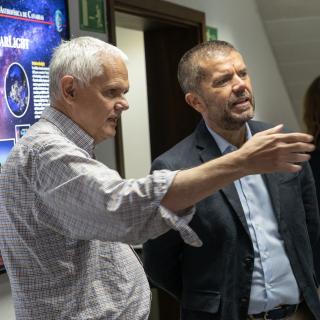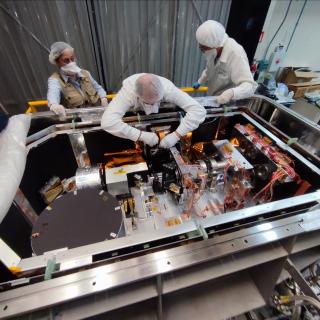The event, which invites participants to ‘Discover the Cosmos and change the world’, will combine science with art and music through various exhibitions and the band Tangerine Dream.
STARMUS, which will coincide with the spring equinox, will also commemorate the 50th anniversary of the flight of Yuri Gagarin, which opened up man’s conquest of space.
Discover the Cosmos and change the world. These are the two premises of the Starmus festival that, from 21 to 26 March 2011, will make Tenerife the world epicentre of astronomy and the space sciences. This international event, in which the Instituto de Astrofísica de Canarias (IAC) will collaborate, has taken up the challenge of bringing to the public every dimension of the study of the stars with a programme uniting art, music and science of first order. Participants will learn about extraterrestrial life and the future of space exploration at first-hand from world-famous researchers, including several Nobel Prize winners and key personalities in the history of space exploration, such as Apollo astronaut Buzz Aldrin and Russian cosmonaut Valentina Tereshkova. They will also witness the artistic side of astronomy, with exhibitions of astrophotography and space art, together with music from Tangerine Dream, who will be introducing for the first time actual sounds from the celestial bodies.
Led by IAC researcher Garik Israelian, Starmus will also pay tribute to the figure of Yuri Gagarin on the 50th anniversary of his pioneering feat. The flight of his ship, Vostok 1, will be remembered by his companions, Valentina Tereshkova, the first woman cosmonaut, and Alexei Leonov, the first man to perform a space walk. These will be joined by other space personalities of stature, including Buzz Aldrin, the NASA astronaut who made the first Moon landing with Neil Armstrong in 1969, and Bill Anders, who on board Apollo 8 took the famous Earthrise photograph of Earth rising above the Moon’s horizon, one of the most iconic pictures of the XX century. In addition to vividly recalling those days, the organizers will also show documents released from secret Soviet archives.
The tribute to Gagarin will be one of the main activities of Starmus, whose backbone will be the cycle of conferences Discover the Cosmos and Change the World! Over three days, foremost researchers will address subjects ranging from the classical question of the existence of extraterrestrial life to global warming, the relationship between exobiology and religion, etc.
This journey through the hot topics of astronomy includes talks on black holes, imparted by Caltech scientist Kip Thorne, and exoplanets, discussed by their discoverer, Michel Mayor of the University of Geneva. Also speaking will be Robert Williams, President of the International Astronomical Union, 2009 Physics Nobel laureate George Smith, and musician and astrophysicist Brian May, who will be enquiring, ‘What are we doing in Space?’
‘108 minutos’, webcast from the GTC to the entire world
These two activities will take place at the Magma Arts and Congress Hall, in Tenerife. But Starmus will also be looking skywards: the ‘108 Minutes round table discussion will take the Festival to the Gran Telescopio Canarias, the largest telescope in the world, located at Roque de los Muchachos Observatory on the island of La Palma. Webcast to the entire world, this discussion will bring together a panel of experts, including Nobel Prize winners Jack Szostack and George Smoot, and such renowned scientists as ethologist and biologist Richard Dawkins, author of The Selfish Gene.
Under the chairmanship of Leslie Sage, senior editor of the science journal Nature, the discussion will cover a range of topics, including the ancestral curiosity of human beings in studying the Universe, the need for space travel, the advantages of manned over unmanned missions and the possibilities of finding intelligent life on extrasolar planets. To tackle these questions, the participants will have at their disposal 108 minutes, the amount of time that Gagarin was in orbit.
Much more than science
Starmus is far more than a series of talks. As part of the event, there will be an exhibition with the results of the first international competition to choose the ‘best amateur astrophoto’, presented by one of the foremost exponents of the subject, David Malin. Moreover, Doctor Jill Tarter, Director of the SETI Research Center (SETI Institute, USA) will bring the SETI Zone to Tenerife. “SETI” stands for “Search for ExtraTerrestrial Intelligence”, which is precisely what those who visit the zone will be doing. Guided by Tarter herself, participants will learn, for example, how to decode messages from outer space.
There will also be space for art. The Space Art and 3D Astronomy: Beyond Your Imagination exhibition will demonstrate the close relationship that artists and researchers have maintained over the years. Thanks to the work of many of them, the public has been able to visualize and understand the significance of the discoveries made by researchers. There’ll be music too. The Starlight concert will bring to Tenerife the high-tech sound of the Tangerine Dream band, six times nominated for the Grammy award, with their unmistakeable performance, on this occasion, with sounds emitted by the stars.
Observing the Canarian sky at the spring equinox
It’s no coincidence that the Starmus Festival should happen at the spring equinox. The organizers will take full advantage of this time of the year – ideal for observing the stars – to offer participants a stunning celestial view from one of the best sites on the planet: the Canary Islands. One such opportunity will be the Teide Star Party, a 2000 metre high fiesta to observe the stars from the National Parador, in the heart of the Cañadas del Teide National Park.


